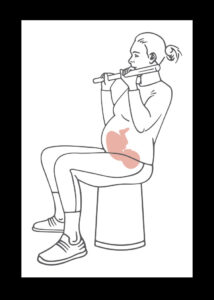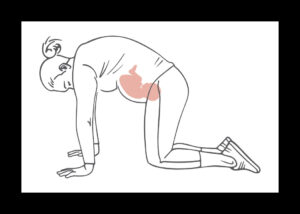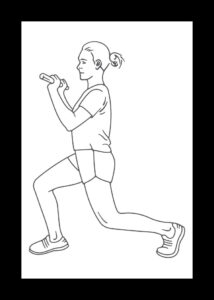
Pregnancy can change your activity levels, but as long as you’re already healthy, there’s no reason to stop working out and lifting weights. Postpartum, you may also be hesitant to hit the gym. Or you may wonder, is it safe? Read on to find out.
Congratulations! Being an active person, you’ll probably want to keep up your current fitness regimen while you’re pregnant. The American College of Obstetrics and Gynecologists (ACOG) says, “Women with uncomplicated pregnancies should be encouraged to engage in aerobic and strength-conditioning exercises.”
Exercise benefits
If you’ve never been active, now is not the time to start a completely new or complicated routine; walking and swimming or gentle prenatal classes will be your safest bet. However, if you’re already a fitness fan, lifting weights and working out are still safe ways to stay fit.
Regular exercise not only is great for your mental health, but, when you’re pregnant, also “improves or maintains physical fitness, helps with weight management, and reduces the risk of gestational diabetes in obese women,” according to ACOG. Common contraindications include
- hemodynamically significant heart disease
- restrictive lung disease
- incompetent cervix
- risk of premature labour
- second or third trimester bleeding
Note: Always get your doctor’s approval before beginning any workout routine.
Prenatal workout
Here is a fun and effective workout for pregnant women.
Warm up first! Always warm up; your body needs time to get ready for exercise. Try treadmill walking/jogging, stationary cycling, or stair climbing for 6 to 10 minutes.
Do 2 to 3 sets of 15 repetitions for each exercise.
Squat to Bench

Muscles targeted: Gluteals and thighs
- Stand in front of a bench with your feet shoulder-width apart or slightly wider.
- Sit back toward the bench and just touch your bum.
- Stand back up, squeezing your buttocks tightly.
Seated Lat Pull

Muscles targeted: Lats and biceps, core
- Sit down at a lat pull machine; grasp the bar with your hands, shoulder-width apart.
- Lean back slightly and pull the bar down toward your sternum. Keep your core strong as you pull down.
- Release your arms back up to the starting position.
Wall Push-Ups

Muscles targeted: Pecs and triceps, core
- Stand as far away from the wall as you can with your hands touching the wall, palms flat.
- Keep your back flat and your eyes forward (chin down).
- Come up on your toes, and bend your elbows out to the sides, bringing your forehead closer to the wall. Ensure your head stays still; your arms are doing the work!
- Push yourself back to the starting position.
Cat-Cow

Muscles targeted: Core
- Get onto all fours with your hands directly under your shoulders, back flat.
- Tighten your tummy and arch your back, engaging your core.
- Release and let your back sway, reaching your shoulder blades
Note: If at any time you feel dizzy or nauseous, please stop exercising right away and sit down. Make sure to stay hydrated by having a glass of water before exercise and sipping water throughout.
Postnatal workout
Following the birth of your baby, it may be safe to start exercising anywhere from a few days following delivery to eight weeks after; it depends on the type of birth and how you feel.
Warm up for 6 to 10 minutes with stationary biking or treadmill/elliptical walking to get your body ready for exercise.
Do 2 to 3 sets of 15 repetitions for each exercise.
Standing Row with Squat

Muscles targeted: Lats and biceps, gluteals, thighs, and core
- Stand facing a pulley (you can also use a band), holding the bar at chest height.
- Take a step back holding the bar, planting your feet and keeping your knees slightly bent.
- Slowly pull the bar toward your chest, palms up, elbows down, and keeping your core engaged as you row.
- Release the bar slowly, then drop down into a squat.
- Stand back up and repeat 15 times.
Slow Crunch

Muscles targeted: Rectus abdominus (superficial ab muscle)
- Lay on your back with your knees bent; brace your core.
- Place your hands behind your head and slowly lift your shoulders off the ground, and hold for 3 seconds.
- Release slowly and repeat 15 to 20 times.
Ab Brace with Leg Lift

Muscles targeted: Transverse abdominus (deep ab muscle)
- Lay on your back with your knees bent.
- Inhale deeply, exhale, and brace your core—imagine a corset tightening around your waist.
- Lift one leg a few centimetres off the ground; release and switch legs.
Bridges

Muscles targeted: Gluteals and thighs
- Lay on your back with your knees bent, arms by your sides.
- Lift your bum off the ground, squeezing your butt cheeks while at the same time lifting your arms up and over your head.
- Lower to the ground and release.
- Repeat 15 times.
Note: Use your body as a guideline; if it doesn’t feel right, don’t do it!
Pre and postnatal workout fuel
For both pre- and postnatal workouts, water is your best fuel. Stay hydrated by having a glass of water before, during, and after your workout.
As a general rule, breastfeeding moms should consume their regularly recommended amount of water to stay hydrated, plus an extra glass every time they feed baby. A simple guideline for optimal hydration is clear urine.
Finding a personal trainer or physiotherapist
To make sure you’re hiring a pro, ask a lot of questions first, including whether the trainer has ever trained pre- and postpartum women. Also, look up your trainer on one of the following websites:
- ACE Fitness: acefitness.org/education-and-resources/lifestyle/find-ace-pro
- American College of Sports Medicine: certification2.acsm.org/profinder
If you have an abdominal separation and want to find the right physio for you in Canada, first talk to your doctor about any referrals she may have. Then, look up physiotherapists here: physiocanhelp.ca/find-a-physiotherapist.
If you have a separation in your abdominals (diastasis recti), you no longer need to avoid crunches unless your physiotherapist recommends it.
While the ab-bracing exercise is safe for most postnatal women and can be started soon after giving birth, crunches have always had a bad rap. But according to pelvic physiotherapist Katie Huack, “… no exercise is inherently evil during or following pregnancy. Whatever exercise an individual chooses to do following pregnancy, the important piece is ensuring they are able to create tensioning across the linea alba and control the intra-abdominal pressure forces (that is, no abdominal doming or coning).”
The bottom line
During and following pregnancy, you can continue to stay as active as you feel able to, which includes working out at home or at the gym. As long as you listen to your body’s cues and have a doctor’s permission to keep exercising, you can continue to stay active and fit in the gym.
Staying active during pregnancy will help give you more strength and stamina during the birthing process as well as getting you to recover more quickly after giving birth. It can also help with posture, mental health, and reducing the risk of gestational diabetes.

